► First hint at production Kia electric van
► Concepts make European debut at 2024 IAA van show
► Three sizes of van coming, UK sales from 2026
The look of the production Kia PV5 electric van has been hinted at on the brand’s stand at the 2024 IAA van show in Hannover. Although the vehicles on the show stand are the same ones that appeared at CES in January 2024, there were a couple of silhouette images of the production versions tucked away on the back of the stand.
Given it’s an outline, it doesn’t give huge amounts of detail but it is possible to determine a couple of crucial factors about the production models. Firstly, the level of tech is being dialled back for the vans that are going on sale – there are conventional door mirrors in place of the camera-and-screen setup of the concepts.
The other notable observation is that the fundamental shapes seem to be much the same, which would back up Kia insiders’ claims that the concepts are very close to the production versions in terms of shape and look. The headlight design is the same basic shape, although slightly less angular.
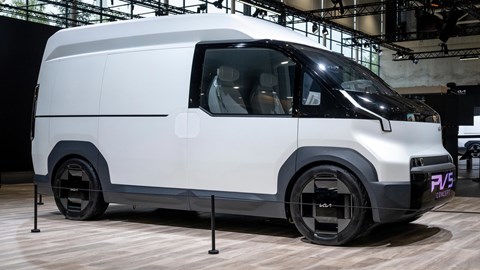
Kia also confirmed some welcome details at the IAA, namely that the PBVs (Kia’s slightly odd name for its vans) will get the same seven-year 100,000-mile warranty as its passenger cars. This would give the Kias one of the longest warranties in the class, with only Toyota’s unsurpassed 10-year cover bettering it.
The other claim is one that you might expect a brand to make about its new vehicles – it is targeting best-in-class performance for elements such as payload, capacity and turning circle. However, this is where it gets it a little unusual, as the dimensions of the PV5 (and its larger sibling the PV7) sit neatly between two categories. It’s slightly larger than conventional small vans such as the Citroen Berlingo but a bit smaller than the medium Ford Transit Custom.
Perhaps conveniently, Kia says that the best-in-class claim refers to the smaller of these two classes. It would make sense that a bigger van has more space inside, but increased payload and a smaller turning circle are both a bonus.
The final confirmation of note was that fast-charging capabilities will be part of the PV5’s offering, too, with up to 150kW on a DC connection and 22kW via AC.
Spotted testing
Our photographers have previously caught the PV5 out testing, while heavily disguised. In a hint at the sort of vehicle that Kia is targeting, it has been spotted alongside the Volkswagen ID.Buzz Cargo – another van that sits between those conventional categories.
However, Kia also had a Hyundai Staria out alongside the PV5, which gives another hint that the brand’s so-called PBV won’t just be your average base-level workhorse white van when it launches in 2026.

We can expect a high level of technology on board, such as drive-by-wire steering and braking, in-wheel motors and highly integrated electric features.
Kia has subsequently said at the IAA that it aims to cover a wide range of potential buyers, though, so there should be a lower-spec model as well as the highly equipped version.
You said the first Kia van – are there more?
Kia revealed as many as five concept vehicles at the CES show in Las Vegas in January as it signalled serious intent to take on the world of electric vans.
The Korean brand hasn’t had any real involvement with the world of commercial vehicles in Europe, but it is looking to change that as it launches its new ‘Platform Beyond Vehicle’ business. And while lots of the early literature has talked about ‘PBVs’, these are light commercial vehicles (LCVs) or just vans in plain English and expect the UK marketing to reflect that.
It is doing far more than just talking about it, though, as it revealed three sizes of van at CES in Las Vegas, with the PV1, PV5 and PV7 shown in concept form, with a PV3 also planned for the future. As well as showing what the vehicles might look like, Kia also outlined how and when it intends to bring these vans to market and what sort of physical and software tech there will be behind them.
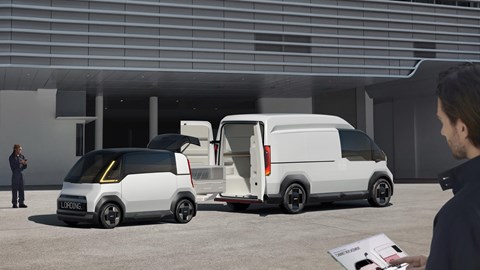
Expect swappable tech and modular assembly so a vehicle can be changed easily and quickly from being a van during the week and a taxi at the weekend.
This suggests you will be able to tweak your Kia electric vans once you have bought it, should your business needs change over time.
Three vans, loads of vehicles
While there will be three fundamental van models, there is scope for many more shapes and sizes in the PBV range, as illustrated by the concept vehicles shown in Vegas. The vehicles are based on an adapted version of the same E-GMP platform under the EV6, but in two lengths and in a ‘skateboard’ style, which means they can be stretched and adapted.
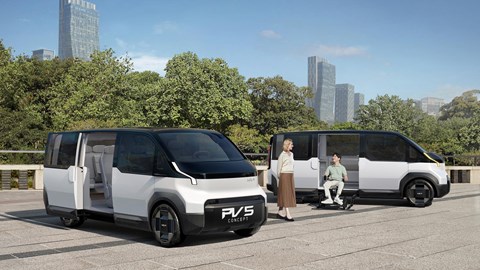
The PV5 is the mid-size van, although it is slightly smaller the likes of the Ford E-Transit Custom. Instead, it’s more like a long-wheelbase Citroen Berlingo or a VW ID.Buzz Cargo.
In a bid to show the flexibility of the architecture, there are several versions of the vehicle on display, with a high-roof model, a people-carrying minibus, a self-driving Robotaxi and even a pick-up truck. Alongside all these was a standard-roof panel van, which is the model that will form the core of the range, if the PV5 is anything like the rest of the van market. This is the one that was given prominence at the IAA too.
This version is around 4.7m long, so fractionally shorter than the Ford, and is set to be offered with front-wheel drive. A longer-wheelbase version is possible for the future, though.
There are some clever-looking touches on the various vehicles, with the high-roof model offering enough space and height for a driver to walk through from the cabin to the loading bay. The people-carrier comes with features such as seats that be configured in various layouts and a sliding see-through partition that divides the cabin from the main seating area in the rear.
The space for the passenger seat is given over to storage in the concepts.
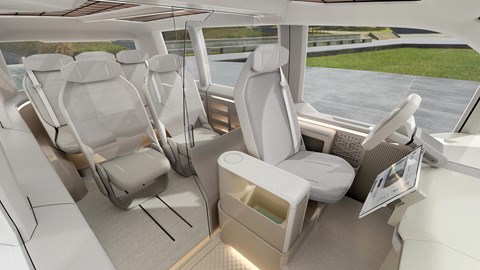
Also on show at CES were a PV1 and PV7 concept, with the latter a larger medium van that will measure around 5m to 5.7m in length. There is little information on exactly how big it is in terms of carrying capacity or how much payload it can take, but it is said to be the largest model in the planned range for now at least and is ‘defined by more space, greater distance, and enhanced functionalities.’
It is set to launch with a front-wheel-drive and four-wheel-drive version.
The PV1, as the name suggests, is the smallest concept on show, but it is even smaller than the conventional small-van class – it is better seen as a last-mile delivery vehicle, similar to the likes of the Citroen Ami. However, this is very much a pie-in-the-sky vehicle for the UK, as it is a self-driving vehicle that is unlikely to be legal on UK roads.

It has some very clever features, though – the loading floor is the same height as the other vans, so anything loaded in can slide from the bigger vehicle to the PV1. It also has a tiny turning circle which is achieved by rotating the wheels around so it can spin on its axis.
There was also a pick-up truck on show, but Kia says this is more of an exploration of what is possible rather than a confirmed model. What is going to come is a PV3, which will be a smaller van – more of a rival to the likes of the Ford Transit Courier.
However, Kia has not said when this will be launched yet and is yet to show a physical vehicle, even in concept form. Instead it appeared as an image on a screen, just briefly, at a presentation in Las Vegas. Expect this to be several years down the line.
More than just boxes on wheels
Given that Kia is launching a range of commercial vehicles with a completely blank sheet, it is little surprise that it is looking to provide more than a selection of basic vans.
There is scope for customisation in various forms, partly courtesy of its so-called ‘PBV Ecosystem.’ This is a posh way of describing the racking and storage possibilities in the rear loading bay, which come via an integrated rail system on the floor, ceiling and internal side walls.
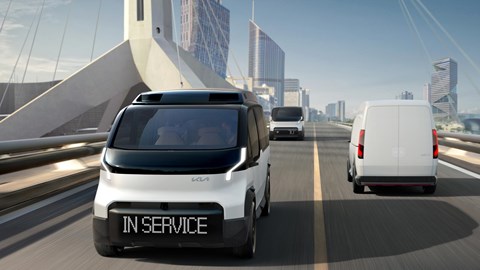
This means that items such as cabinets and frames for internal racking and storage solutions can be easily swapped in and out of various vehicles. By offering such features from the factory, this could remove the need for many customers to head straight to a third-party to get a load of systems fitted in the back as soon as they have bought their van.
However, it is not yet clear whether buyers will be able to fix in the sort of racking that they have been using in vehicles for many years – plenty of van owners will transfer the fixtures and fittings from their old vehicle to a new one when they replace it.
The current plan is for the PV5 to be front-wheel drive only, while the PV7 will be front-wheel drive and four-wheel drive.
When can we buy the Kia PBVs? Sorry, the Kia electric vans?
Despite Kia’s standing start, we shouldn’t have long to wait until the brand’s electric vans head out to the market. The first PV5 model was originally planned to come as soon as 2025 however, this has now been pushed back to 2026. Production
While UK pricing has not yet been set, Kia has said that the PV5 will start at around 35,000 Euros (around £30,000) when it goes on sale.
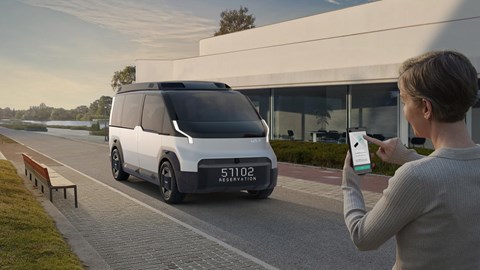
It has said that it sees there being three phases to the PBV rollout, with the PV5 set to be the first model to go on sale in late 2025, followed by the PV7 in phase two, which will start around 2027.
As well as the PV5, phase one will also see the launch of some of the software that will be supporting the vehicles.
The PV1 will follow in 2028 where it is legally permitted. This phase will then bring more connectivity and the PBV Ecosystem that will allow the vehicles to swap cargo between each other.
What does the future hold for the PBVs?
Phase three is less defined at this stage in terms of precise vehicles or products, but this is when Kia is saying it expects to be able to add the sort of future tech that isn’t possible right now – a greater degree of self-driving ability, robotics, Artificial Intelligence and even Advanced Air Mobility (AAM). This is currently set as being from 2032 onwards.
The AAM ecosystem is being developed by Supernal, which is looking at the mobility possibilities that could be available, while Boston Dynamics is looking at what could be done with robotics.